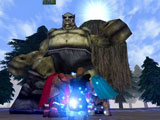 Before Dark Age of Camelot, I had
hit the massively multiplayer on-line role playing game (MMORPG) wall. Though I enjoy the
genre thoroughly, I’d burned out on EQ when it became apparent that week-long camps
were a fact of gaming life at the higher levels (and I have a whole other non-gaming life
that requires some of my time). It didn’t help my gaming ennui any when
two of this year’s much-anticipated MMORPG’s--Anarchy Online and World War II
Online—had launches that can only be described as catastrophic. So when Mythic
released Dark Age of Camelot, an MMORPG of vast ambition and scope, we thought we were
just being realistic by expecting the worst—server crashes, bugs, loopholes, uneven
gameplay, lag—you name it. Remarkably, none of this has come to pass; in fact, Dark
Age of Camelot is very stable as a program and extremely enjoyable as a game. It’s
shaken the MMORPG blues right outta me.
Before Dark Age of Camelot, I had
hit the massively multiplayer on-line role playing game (MMORPG) wall. Though I enjoy the
genre thoroughly, I’d burned out on EQ when it became apparent that week-long camps
were a fact of gaming life at the higher levels (and I have a whole other non-gaming life
that requires some of my time). It didn’t help my gaming ennui any when
two of this year’s much-anticipated MMORPG’s--Anarchy Online and World War II
Online—had launches that can only be described as catastrophic. So when Mythic
released Dark Age of Camelot, an MMORPG of vast ambition and scope, we thought we were
just being realistic by expecting the worst—server crashes, bugs, loopholes, uneven
gameplay, lag—you name it. Remarkably, none of this has come to pass; in fact, Dark
Age of Camelot is very stable as a program and extremely enjoyable as a game. It’s
shaken the MMORPG blues right outta me. 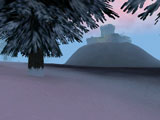 If you’re familiar with
Everquest, you’ll feel right at home with Dark Age of Camelot. Many of the
games’ conventions are similar, and the differences between the games are much like
the differences between, say, Quake II and No One Lives Forever. Essentially, DAoC takes
the basic EQ model, addresses many of the issues EQ players have had with that game, adds
a workable PvP system, and offers up a deep and beautiful game world. It all adds up to
the best MMORPG experience out there right now.
If you’re familiar with
Everquest, you’ll feel right at home with Dark Age of Camelot. Many of the
games’ conventions are similar, and the differences between the games are much like
the differences between, say, Quake II and No One Lives Forever. Essentially, DAoC takes
the basic EQ model, addresses many of the issues EQ players have had with that game, adds
a workable PvP system, and offers up a deep and beautiful game world. It all adds up to
the best MMORPG experience out there right now.
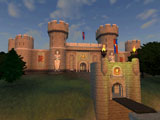 The DAoC
game world is set in a time after the death of King Arthur, as three warring realms now
struggle for supremacy. Albion is the realm of Arthur. It’s populated by humans, and
looks and feels a lot like medieval England—even the areas are named after famous
British landmarks, like Stonehenge and the Salisbury Plains. If you choose to create a
character in Albion, you’ll have a wide variety of classes to choose from—both
warriors and casters. Midgard is a realm right out of Norse mythology, and is strewn with
pine forests and snowy mountains. In this realm your character can not only be a human,
also a kobold, dwarf, or trolls. Midgardians are fierce in hand-to-hand combat, and your
caster choices are very limited in this realm. Hibernia is the Celtic land of faerie and
magic, and character choices here include such races as Elves, Celts, Lurikeen and
Firbolgs. Magic is the coin of the realm here, and casters are a Hibernian specialty.
It’s a tribute to the crew at Mythic that each of these realms looks, feels and plays
very differently from each other. The first time my Midgardian Dwarf Berserker
participated in an invasion of Hibernia, it felt strange—way too green and unearthly.
The DAoC
game world is set in a time after the death of King Arthur, as three warring realms now
struggle for supremacy. Albion is the realm of Arthur. It’s populated by humans, and
looks and feels a lot like medieval England—even the areas are named after famous
British landmarks, like Stonehenge and the Salisbury Plains. If you choose to create a
character in Albion, you’ll have a wide variety of classes to choose from—both
warriors and casters. Midgard is a realm right out of Norse mythology, and is strewn with
pine forests and snowy mountains. In this realm your character can not only be a human,
also a kobold, dwarf, or trolls. Midgardians are fierce in hand-to-hand combat, and your
caster choices are very limited in this realm. Hibernia is the Celtic land of faerie and
magic, and character choices here include such races as Elves, Celts, Lurikeen and
Firbolgs. Magic is the coin of the realm here, and casters are a Hibernian specialty.
It’s a tribute to the crew at Mythic that each of these realms looks, feels and plays
very differently from each other. The first time my Midgardian Dwarf Berserker
participated in an invasion of Hibernia, it felt strange—way too green and unearthly.
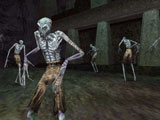 Though
you can happily play DAoC without getting into realm-vs-realm combat, it is the real heart
of the game, and what sets it apart from other MMORPGs. As your character gains levels,
you’ll find yourself more and more drawn to your frontier areas to protect them from
invaders from the other realms, or to handy transport pads to invade their realms. RvR
combat is fast and furious, and it takes a good amount of teamwork to capture enemy
fortresses and relics. This makes being in a guild good for something besides group camps,
getting twinked by higher-level members, and power-leveling (which is near-impossible to
do in DAoC anyway.)
Though
you can happily play DAoC without getting into realm-vs-realm combat, it is the real heart
of the game, and what sets it apart from other MMORPGs. As your character gains levels,
you’ll find yourself more and more drawn to your frontier areas to protect them from
invaders from the other realms, or to handy transport pads to invade their realms. RvR
combat is fast and furious, and it takes a good amount of teamwork to capture enemy
fortresses and relics. This makes being in a guild good for something besides group camps,
getting twinked by higher-level members, and power-leveling (which is near-impossible to
do in DAoC anyway.)
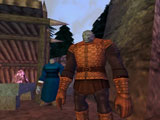 The
game’s graphics are excellent throughout. Player models are colorful and
well-animated, especially when performing special style attacks. Each realm has a wide
variety of great-looking and often unique monsters and NPC’s, ranging from stuff like
innocuous-looking but deadly basilisks to awesome giants. Weather effects are nicely done,
and even events as mundane as sunrises and sunsets can be very beautiful. But the most
impressive graphics display occurs in the game’s spell effects, which are just
outrageous.
The
game’s graphics are excellent throughout. Player models are colorful and
well-animated, especially when performing special style attacks. Each realm has a wide
variety of great-looking and often unique monsters and NPC’s, ranging from stuff like
innocuous-looking but deadly basilisks to awesome giants. Weather effects are nicely done,
and even events as mundane as sunrises and sunsets can be very beautiful. But the most
impressive graphics display occurs in the game’s spell effects, which are just
outrageous.
I suppose the best way to describe gameplay in DAoC is to note some of the ways it
improves upon gameplay in EQ. Let me count the ways, ten of ‘em:
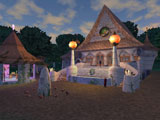 1. No
twinking. In DAoC, you can’t wear armor that’s not intended for a character of
your level—you can stretch things a bit, but armor that cons red or purple to you
won’t do you any good. To wear really cool stuff, you’ll usually have to get it
yourself—you just can’t count on higher level friends to give you ultra-cool
items. In the same vein, you’re severely punished, exp-wise, if you group with
players much higher than you.
1. No
twinking. In DAoC, you can’t wear armor that’s not intended for a character of
your level—you can stretch things a bit, but armor that cons red or purple to you
won’t do you any good. To wear really cool stuff, you’ll usually have to get it
yourself—you just can’t count on higher level friends to give you ultra-cool
items. In the same vein, you’re severely punished, exp-wise, if you group with
players much higher than you.
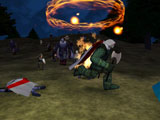 2.
Questing. Thankfully, you can usually find very nice items by doing some of the many
quests available in the game. And the quests are much, much, saner than those in EQ. For
one thing, they’re doable in a reasonable amount of time, and since the MoBs in DAoC
spawn much faster than in EQ, you usually won’t have to squabble with other players
over who gets to camp spawns.
2.
Questing. Thankfully, you can usually find very nice items by doing some of the many
quests available in the game. And the quests are much, much, saner than those in EQ. For
one thing, they’re doable in a reasonable amount of time, and since the MoBs in DAoC
spawn much faster than in EQ, you usually won’t have to squabble with other players
over who gets to camp spawns.
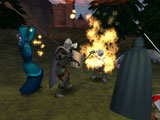 3.
Rational Death Penalty. It’s no fun to die in DAoC, but at least you respawn at your
bind point with all your stuff—no more naked suicide runs through MoB-infested
dungeons just to get your gear. You take a hit in experience (part of which can be
recouped by visiting a grave at your death site and praying) and on your constitution
(which can be restored by paying a healer), but this relatively light death penalty allows
you to take many more chances, especially since you never lose a level by dying. And since
most healers get resurrection at a very early level, you usually don’t even have to
return to your bind point.
3.
Rational Death Penalty. It’s no fun to die in DAoC, but at least you respawn at your
bind point with all your stuff—no more naked suicide runs through MoB-infested
dungeons just to get your gear. You take a hit in experience (part of which can be
recouped by visiting a grave at your death site and praying) and on your constitution
(which can be restored by paying a healer), but this relatively light death penalty allows
you to take many more chances, especially since you never lose a level by dying. And since
most healers get resurrection at a very early level, you usually don’t even have to
return to your bind point.
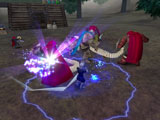 4. Fun
Combat. In EQ, hand-to-hand combat is a bit of a drag. You just sort of hit the attack
button once and hope for the best. In DAoC, you allocate skill points to gain special
style attacks for certain weapons. You can use these attacks in different circumstances in
combat (and so long as your stamina holds out), and it adds a whole new dimension to
fighting.
4. Fun
Combat. In EQ, hand-to-hand combat is a bit of a drag. You just sort of hit the attack
button once and hope for the best. In DAoC, you allocate skill points to gain special
style attacks for certain weapons. You can use these attacks in different circumstances in
combat (and so long as your stamina holds out), and it adds a whole new dimension to
fighting.
5. More Spells. Lots of ‘em, and you get new ones just about every time you level.
No more waiting several levels for your next rack of spells; here you’re always
getting some cool new thing to do.
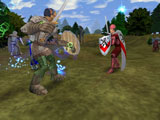 6. Less
Down Time. There’s nothing worse than fighting a MoB, getting a little exp, and then
waiting for five minutes until you heal up enough to take on another. You’ll still
have some down time in DAoC, but healing takes much less time and healing spells seem much
more powerful. Less down time=more time for fun.
6. Less
Down Time. There’s nothing worse than fighting a MoB, getting a little exp, and then
waiting for five minutes until you heal up enough to take on another. You’ll still
have some down time in DAoC, but healing takes much less time and healing spells seem much
more powerful. Less down time=more time for fun.
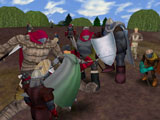 7.
Crafting. Well, it’s still beyond me why anyone would want to spend time learning to
tailor with all those monsters to be killed, but those who do have informed me that
it’s much easier to be come proficient in making armor and weapons in DAoC; I’m
sure there’s still a degree of tedium involved, but to a markedly lesser degree. And
since some types of very powerful armor and weapons must be crafted, there’s always a
demand for items. You can make some money doing this.
7.
Crafting. Well, it’s still beyond me why anyone would want to spend time learning to
tailor with all those monsters to be killed, but those who do have informed me that
it’s much easier to be come proficient in making armor and weapons in DAoC; I’m
sure there’s still a degree of tedium involved, but to a markedly lesser degree. And
since some types of very powerful armor and weapons must be crafted, there’s always a
demand for items. You can make some money doing this.
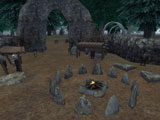 8.
Grouping. While you can solo happily in DAoC, I’ve never seen a game that so strongly
encourages grouping. The interface includes a window that allows you to list yourself as
looking for a group, as well as allowing groups to list what classes they’re seeking.
The group window not only lists each member of your group, but also their health and spell
power status and whatever spells or buffs they have up at the time. It’s also easy to
found and expand a guild—there are a lot of good ones in the game, and many of them
specialize in RvR.
8.
Grouping. While you can solo happily in DAoC, I’ve never seen a game that so strongly
encourages grouping. The interface includes a window that allows you to list yourself as
looking for a group, as well as allowing groups to list what classes they’re seeking.
The group window not only lists each member of your group, but also their health and spell
power status and whatever spells or buffs they have up at the time. It’s also easy to
found and expand a guild—there are a lot of good ones in the game, and many of them
specialize in RvR.
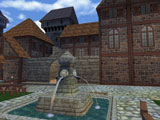 9.
Customizing your armor. I know, it’s petty, but I really like this. You can buy dyes
from merchants and color your armor in whatever scheme you like. This adds a very nice
dash of individuality to the game. No longer does every level 32 paladin look like they go
to same Catholic school.
9.
Customizing your armor. I know, it’s petty, but I really like this. You can buy dyes
from merchants and color your armor in whatever scheme you like. This adds a very nice
dash of individuality to the game. No longer does every level 32 paladin look like they go
to same Catholic school.
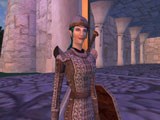 10.
Realm vs. Realm. Have I mentioned this before? There’s nothing like planning with
your guild, unlimbering some siege machinery, ambushing some unwary Hibernians in their
frontier, and taking an enemy fortress. It’ll take a while to get to the level where
you can survive for an extended period of time (usually in the 20s), but it’s one of
the best gaming experiences I’ve ever had.
10.
Realm vs. Realm. Have I mentioned this before? There’s nothing like planning with
your guild, unlimbering some siege machinery, ambushing some unwary Hibernians in their
frontier, and taking an enemy fortress. It’ll take a while to get to the level where
you can survive for an extended period of time (usually in the 20s), but it’s one of
the best gaming experiences I’ve ever had.
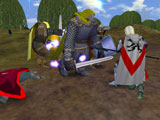 While
it’s clear that I’m very impressed with DAoC, it does have a few problems.
First, as with most MMORPG’s, it gives barely enough information to get started.
You’ll soon enough have questions that the skimpy manual can’t answer. You can
of course get plenty of them by asking around in-game, which is probably the ostensible
motivation for this lack of instruction, but as with EQ you’ll soon find yourself
seeking out some of the excellent DAoC websites. Here are a few I find most helpful:
Camelot Warcry, Allakhazam’s, and Camelot Lore.
While
it’s clear that I’m very impressed with DAoC, it does have a few problems.
First, as with most MMORPG’s, it gives barely enough information to get started.
You’ll soon enough have questions that the skimpy manual can’t answer. You can
of course get plenty of them by asking around in-game, which is probably the ostensible
motivation for this lack of instruction, but as with EQ you’ll soon find yourself
seeking out some of the excellent DAoC websites. Here are a few I find most helpful:
Camelot Warcry, Allakhazam’s, and Camelot Lore.
DAoC also has a notable paucity of dungeons, especially when compared to EQ, and
players will often find the few in their realm to be overcamped and crowded, especially
since rare loot often drops in them. More and bigger dungeons wouldn’t hurt at all.
Overall, Dark Age of Camelot is the best and most fun MMORPG going. It’s big,
it’s beautiful, it’s full of variety that encompasses many styles of gameplay.
Just when you think it might start getting old, you discover a new area or enemy or item
or style of play that breathes new life into it. Worth the ten or so bucks a month to
play? Oh yeah, worth that and more.
